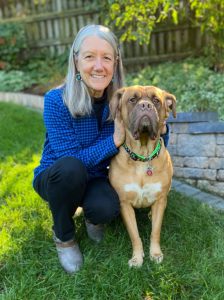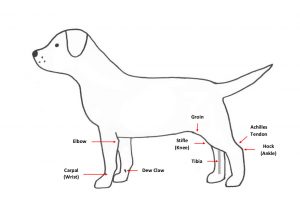
Terry Lackmeyer
Customer Service Representative
For those of us who work with dogs daily, anatomical names are second nature. Sometimes, we forget that not everyone understands those terms, so in this post we will look at commonly used names of the dog’s anatomy and gait.
The diagram below points to the location of each part. The human equivalent appears in parenthesis. Hopefully, understanding these terms will make using the brace and discussing any issues or concerns easier and that will help both you and your dog to enjoy a happier experience with the brace.

Achilles Tendon – large complex tendon that runs up the center back of the dog’s rear leg, below the knee but above the hock/heel.
Carpal – the joint on the front leg that is equivalent to the wrist in humans. This is the first joint above the front paw.
Carpal Hyperextension – refers to the collapse of the carpal joint causing it to move closer to the ground.
Dew Claw – the claw located higher on the inside of the leg above the paw. On the front leg, it reminds many people of the thumb in humans. Dogs can have dew claws on the front and/or back paw, and some breeds even have two dew claws on each back paw. Frequently, dew claws are removed when puppies are extremely young. They really have no purpose, except in specific breeds, such as Great Pyrenees and Kuvaszs, where they served a purpose for the work the dog was originally bred to perform and are now part of the breed standard.
Elbow – the joint, above the carpal, at the top of the front leg, closest to the dog’s body. Dogs only have elbows in their front legs.
Groin – the inside section at the top of the dog’s back legs where the legs join the body. This is like the groin area in humans, where the leg joins the torso.
Hock – the joint on the rear back leg equivalent to the ankle in humans. This is the first joint about the rear paw.
Knuckling – term of function that refers to dogs curling their toes under when walking. They are not walking entirely on the paw pad; they are walking on their curled toes or knuckles.
Stifle – the knee of the dog. This is equivalent to the knee in humans. Dogs only have stifles/knees in their rear legs.
Tibia – the long bone in the lower portion of the dog’s rear leg which is equivalent to the shin in humans. This is the bone that “moves forward” when the dog has a cranial cruciate ligament tear. The forward movement of this bone elicits a “positive drawer” when manipulated by the veterinarian.
Toe Touching – term of function that refers to the dog just touching the ground with the tip of their toes; they are not putting weight on the paw. This behavior is frequently seen in dogs with cranial cruciate ligament injuries.
